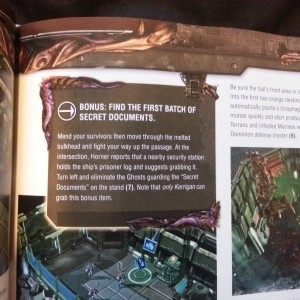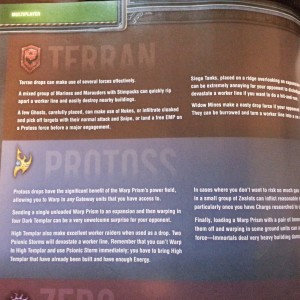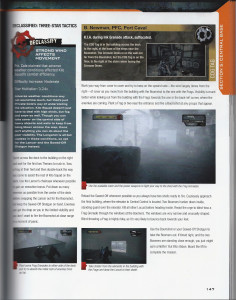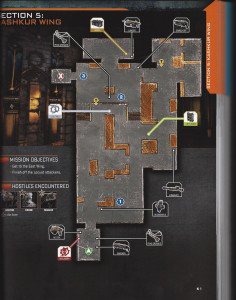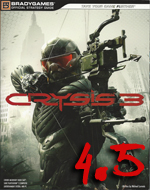 The first BioShock took gamers to a disturbing utopia at the bottom of the ocean, and BioShock Infinite took players to an equally disturbing utopia high in the clouds. Both games were filled with well-hidden collectibles and plenty of venues for exploration, which is exactly why I wanted the strategy guides in the first place. The collectibles in both games included audio files that really fill in the overall story, and since I missed a few audio files with the first game, I really wanted to make sure I found them all the first time with BioShock Infinite. As such, I had almost as high of expectations with the BioShock Infinite strategy guide as I did the video game itself. While I was able to find all of the Voxophones in this game thanks to the guide, the strategy guide completely failed me on finding another collectible. Couple this with the fact that I had problems with the strategy guide’s overall presentation, I was almost as disappointed with the BioShock Infinite strategy guide as I was with the game.
The first BioShock took gamers to a disturbing utopia at the bottom of the ocean, and BioShock Infinite took players to an equally disturbing utopia high in the clouds. Both games were filled with well-hidden collectibles and plenty of venues for exploration, which is exactly why I wanted the strategy guides in the first place. The collectibles in both games included audio files that really fill in the overall story, and since I missed a few audio files with the first game, I really wanted to make sure I found them all the first time with BioShock Infinite. As such, I had almost as high of expectations with the BioShock Infinite strategy guide as I did the video game itself. While I was able to find all of the Voxophones in this game thanks to the guide, the strategy guide completely failed me on finding another collectible. Couple this with the fact that I had problems with the strategy guide’s overall presentation, I was almost as disappointed with the BioShock Infinite strategy guide as I was with the game.
Plenty of the strategy guide was absolutely fantastic. I admit that I rarely look through the front sections of strategy guides unless I need help choosing a character or class or if the game absolutely fails in properly teaching me the control scheme. However, as I flipped through the strategy guide one day, my eyes caught two tidbits that made me stop, turn back, and give the front sections more attention. The first was the code players could tap in to unlock the 1999 Mode, which traditionally unlocks after you complete the game for the first time. It turns out you don’t have to wait for the punishing difficulty level; you only need to enter in the world famous Konami Code. A few other websites posted this after the game’s release, but I was blissfully unaware (as usual) until I noticed this in the strategy guide, and yes, it garnered a chuckle.
The second thing that surprised me about the front section of the guide was the breakdown of Gear combinations to create specific builds for Booker. For example, for the Wizard build of Booker, the strategy guide suggests wearing the Storm Hat, the Blood to Salt Shirt, the Overkill Boots, and the Head Master Pants so that Booker can primarily focus on using elemental Vigors such as Shock Jockey and Devil’s Kiss. Since I focused on staying alive as long as possible, I wish I had looked at this section sooner, so I could have tried out the Defender combination, which looks like it would have been far more effective than the combination I used.
I primarily used the strategy guide to ensure I did not miss any collectibles in the game, since this is actually the most challenging portion of the game (unless you’re playing on the hard or 1999 difficulties). The world of BioShock Infinite is massive, and it’s incredibly easy to miss the large number of collectibles scattered about, especially since so many are hidden in high places or only appear after going through Tears. I am very pleased to say that thanks to the strategy guide, I did find every telescope, Kinetoscope, and Voxophone. There is absolutely no way I would have found them all without assistance, as there was more than one occasion that I would have overlooked them when coming through a Tear, while they hid behind signs on top of buildings, or as they popped up during high action sequences that spurred me to move on instead of exploring like I should have.
That said, however, I never found every Infusion the game offered. When that Achievement didn’t unlock, I was honestly confused, as I could have sworn I found every single one the strategy guide pointed out. The game said I found 23 Infusions, and apparently there are 30, allowing players to max out all three levels for Booker. I assumed I didn’t follow the strategy guide as carefully as I thought, so I started to count the marked Infusions, and I noticed something rather intriguing.
- Infusions marked on maps–22
- Infusions listed in chapter summary (see bottom of image on right)–25
- Infusions mentioned in written walkthrough–22
I counted each of these about three times, because I couldn’t believe how they didn’t add up. As I puzzled over it, I noticed that on a few occasions, the number of the Infusions shown on the chapter maps didn’t match the number listed in the chapter summary below the map, as shown to the right. No wonder I didn’t find them all; not all of them were even listed in the strategy guide! I had hoped that maybe there was an appendix in the back that listed all the locations, but no such luck.
I also can’t help but think if the guide writers or book designers had made call-out boxes in the written walkthrough depicting where each Infusion was hidden, like they did with the Kinetoscopes and Voxophones, perhaps the all of the Infusions would be properly marked. Then again, the walkthrough has so many call-out boxes as it is, perhaps it would have worsened the strategy guide’s overall presentation.
The strategy guide is divided by game chapters (which are separated by Achievements/Trophies), then again by mission objective and scene. Each new scene kicks off with its own map and collectible summary with the written walkthrough to follow. Sometimes the written walkthroughs for a scene are placed before the scene map, which makes following along with both the writing and the maps quite confusing. I couldn’t decide while playing if this was a result of how the game is and the book designers did the best they could or if this was just a bad strategy for the book. Sometimes it was definitely the former, the product of the game, and sometimes it was the latter. As a result, I found myself looking at the book more than I wanted, forcing me to pause the game more often than I wanted, just so I could attempt to find out where I was between the walkthroughs and the maps. I do blame how long it took me to finish the game on how much time I had to stop to read the strategy guide. I like strategy guides to make my game times more efficient, and I felt like this one greatly slowed me down.
The BioShock Infinite strategy guide is very, very hard for me to recommend. On the one hand, I found two-thirds of all of the collectibles with its help, unlocked all of the side quests, and I’m certain I found all the Gear in the game even though there was no Achievement to tell me so. I also really enjoyed the extra developer commentary that was sprinkled throughout, and I most likely didn’t die as often I would have without its help. At the same time, I’m really disappointed in the Infusion problem, and I can’t get over how often I got lost in the book, which took away too much time from the game. The BioShock Infinite strategy guide is definitely above average, but it’s not one of BradyGames’ best either.
SGR Rating: 3.5
Authors: Doug Walsh and Logan Sharp
Publisher: BradyGames
Editions Available: Paperback and Collector’s Edition
Acquired via Publisher


